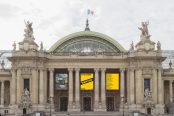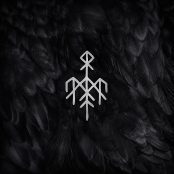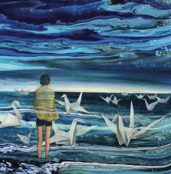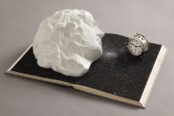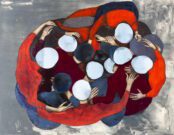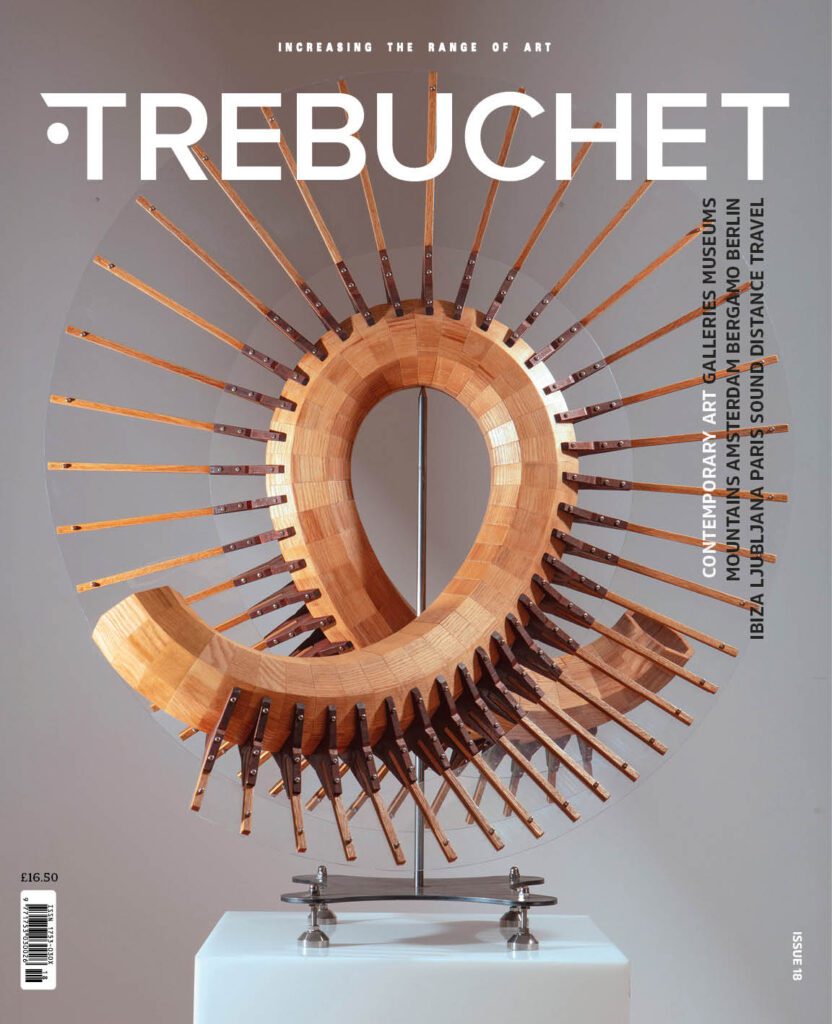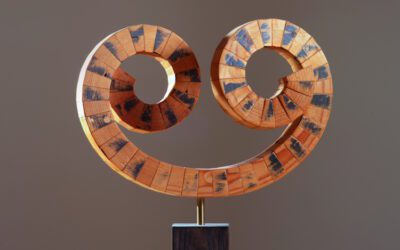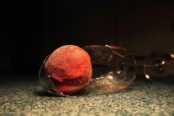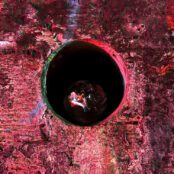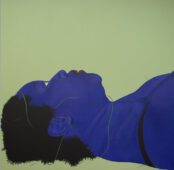Is a painting really more than colour and shape on a canvas? Paint itself isn’t a necessary vehicle for art and each bold new movement toward the conceptual and the virtual broadens what we can use. So, why not firework art?
Marcel Duchamp said “I don’t believe in art I believe in artists”. If there is anything timeless we can say about art it is that it’s the mind of the creator that will out when we have a medium more immediate than the pen, brush, or chisel. Art is the process of capturing something ethereal and giving it a transmissible form, a mental shape that catches on and ignites in the mind of the viewer. The process itself is often represented symbolically or allegorically, the spark of creativity, the flame of passion, in characters like Prometheus who stole the fire of the gods. Artists who use fire itself in their works channel the symbol and create work that captures the heat of inspiration in a very literal manner.

One such artist is Jeremy Howe. Born and raised in New Mexico, since 2000, he has been driven to perfect the use of fireworks as an artistic medium. At this stage he is one very few artists who have mastered capturing coloured smoke and oxidation trails on paper in an interesting way. Exhibiting primarily in New Mexico, he has shown at the Ft. Collins Museum of Contemporary Art, Roswell Museum and Art Center, and the International Museum of Art in El Paso. Intrigued by this unusual medium Trebuchet asked Howe what first inspired him and what he’s found in this incendiary art form.
How did you get started?
This would be the summer of 1979 in Roswell, New Mexico. My sister Miranda and I were walking back home after purchasing our beat-the-heat slurpies from the up-the-road 7–11 convenience store. We passed a small, stooped over man who was unloading boxes of fireworks up the steps into his home and we asked him if we could help. He was pleased about that and put us to work unboxing and arranging fireworks on the shelves of his living room for display. I think he knew that we were having a good time.








When we left that afternoon, Firework Joe loaded us both up with as many fireworks as we could hold in our arms and carry home. This was about a block away. We picked out smoke balls, ground spinners, chasers, fountains, parachutes, and firecrackers.
At 10 years of age, colour was already important to me and I gravitated to the coloured smoke balls. I knew I could throw them, but wondered what else I could do. Buried in the sand was cool, submerged in water was interesting, but my favourite was holding them in my hand and drawing with it like a paint brush. I figured out how to ‘smoke’ my name on surfaces and then started making actual 10-year-old kid drawings on the sidewalks and walls. I remember the blue smoke was particularly vivid and spectacular.
Some 21 years later in the summer of 2000, I was living in Las Cruces, NM. I was also the office manager for Phantom Fireworks and had free use of all the damaged fireworks. Like a creature of habit, I got into the smoke balls and grabbed up a blue one wondering what I was going to do with it. I spied the dull white bumper of Ole Blue Eyes, my 1978 VW bus, and proceeded to ‘polka dot’ the bumper in the fashion of Randy Rhoads’ Flying V guitar. That very day it occurred to me that I should be able to use this to make marks on paper. That was a jumping-off point into this great wild beyond. My first firework pieces are from summer of 2000.
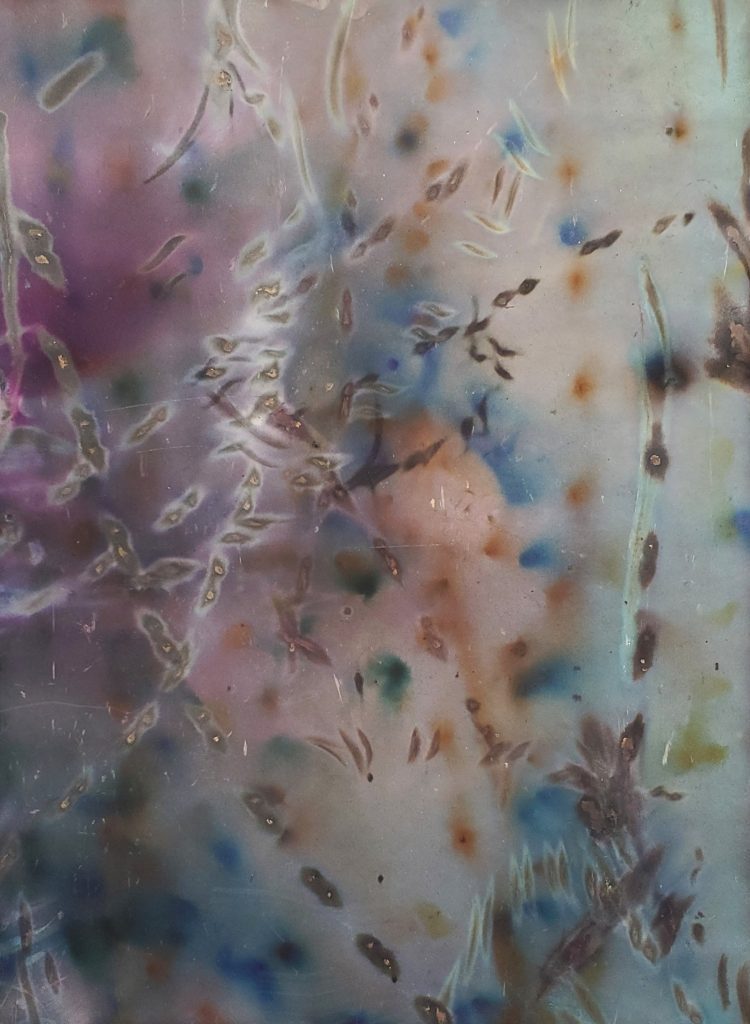
How would you describe your technique so far?
I did not have exemplars for creating art on paper with fireworks so my technique is definitely self-invented. With the initial pieces, I used a metal baking pan and inverted it to create a containment field for the fireworks. This first exploration produced what I call the ‘pyroglyphs’ or fire-writing. I had not yet introduced coloured smoke, but used spinners, in this case, ground bloom flowers, to create oxidation trails or burn marks onto the surface of the paper. My next logical step was to add colour to the equation. By simultaneously lighting the smoke ball and spinner, quickly covering it with my containment ‘oven’, picking the whole thing up and shaking it around so no burning hot spots were created on my paper, I was able to produce my second series. As I learned to master the energetic materials and my curious tools, it felt very natural to introduce new ideas and variables. Since there were no imposed technique rules, I embraced the freedom to heartily experiment.
Almost anything I could think could be used as a stencil. The use of torn paper, rice, crunched up leaves, BBs, pennies, bottle cleaners, wooden skewers, popsicle sticks, dirt, grass, and macaroni noodles have all made it into my art as stencil tools. Multiple firings have produced fantastic complementary colours with watercolour-like transparency. I have drawn with the billowing smoke balls like one would with an airbrush. Folding the paper, colour-smoking, unfolding, refolding, and colour-smoking again is a great technique that can give a mineralogical texture while feeling cathedral-esque. Surely there must be a never-ending wellspring of technique, all of it speaking the language of fireworks.
Who has inspired you so far?
With the immense blessing of growing up in a family filled with artists, foremost would be my dear grandfather, the New Mexico born painter, Bill Wiggins. Gramps influenced my perception of art, what it can be, what it can do, and how to live well with it. My mother, Elaine Howe, taught me how to experiment and this exploratory nature has been fundamental in my work. From them both, I learned creative thinking, problem-solving, and a tunnel-vision I-AM-ON-FIRE prolificity.
In 1999 I had an awakening after purchasing a tube of Pepto-Bismol pink oil paint from a Denver garage sale and began painting up a storm. I couldn’t paint enough, think enough, learn enough or read enough, and it was during this time that I became aware of the current limelight artists. For me, these were Tracey Emin, Damien Hirst and Thomas Kinkade, and I could not stand their work! At that time, it made no sense to me that the writers of art history were swooning over a cathartic pity-party painter, an idea thief, and a mass-market lollipop laner. Early on, these three were highly influential to me.
As my love for art history grew deep and wide, it became apparent that EVERYONE was an influence, including musicians, scientists, and lawmakers. Paul Klee, Alberto Burri, and Joseph Beuys have been incredibly impactful and remain my go-to mystical giants of the highest regard.
What is your most successful artwork and why?
In the wonderland of Gramps’ painting studio, he had a copper enamel station set up for the grandkids. With great joy, he showed us the basics of how to enamel on copper pennies with the coloured powdered glass and a propane blow torch. From this experience I not only learned detail, colour relationships, respect for materials, and fire safety, but realised that I loved this medium. Years later as a traveling artist within the public school system of Las Cruces, New Mexico, I was able to sit down with groups of young kids and do just what Bill Wiggins did for me. Each enamelled penny was a tiny canvas of beautiful success, filled with fire magic and colour mystery. This surely helped spark a great and necessary sense of science knowledge, accomplishment, and creative pride within each child. Now THAT is successful artwork!

How have people reacted to your artwork?
Disbelief, speechlessness, amazement, surprise, wonder, curiosity, befuddlement and confusion are not unusual reactions. I’ve been asked how I print them or if I use light-sensitive paper. To me, the entire reactionary gamut makes sense. It is tremendously difficult to imagine and comprehend such a process without actually seeing it in person. I have had quite a few requests to make process videos.
What has been the most important discovery in your practice to date?
The biggest bang for my buck would be the rudimentary stacking of transparent colour upon colour to create an entirely new colour. It should be recognised as one of the most elemental and powerful tools in the firework art arsenal.
What is the role of emotion in firework art?
It takes a lot of work being an emotional creature. To feel this way or that all the time is an exhausting, life-long pendulum swing. For me, the making of art short-circuits all of that. It transcends the fickle, kills time, and has brought me the only peace I have ever known. My firework art isn’t emotionally-based, forsooth, it is passion-based in its intense, unrelenting, and untamed conviction.
Drawing… now that’s a great venue to spill emotion! With a ballpoint pen I’ve worked out many moments in time of love, hate, attraction, and revulsion.
Is it hard to plan firework art?
If it is the start of a brand new series I will give consideration to size, orientation, type of paper, and what kind of process. I like to establish generalities and let the act of creation run its course. It’s a proximodistal tendency. The colour choices, pattern creations, saturation level, and complexity, i.e., the details, are mostly done on the fly.
Where should people start with your artwork?
In my work I use a motley assortment of materials, making for a wide range in the types of art. Imagine a box that contains a blue pen, a dirt clod, a bar of silver, three packs of Newtons (fig, raspberry, and blueberry), wax teeth, a Black Flag album, a bible, and some bottle rockets. What do you look at first and how is that determined? We as humans aspire to reason. Since the order and arrangement of diverse objects for sensical viewing brings coherence, I might start chronologically with the firework art. That can be from the first piece to the most recent, or even do it in reverse. Ponder and laugh at the food art. Peruse the paintings together. Consider the drawings together. Take a random batch at a time and do it for multiple days. There are multiple ways. I recommend the firework art first and leave the rest for another day. There is so much there it can be overwhelming.
What interpretation of firework art has surprised you the most?
For me, titles are an indispensable part of my work and, funnily enough, there have been times that the titles are better than the work itself. With that, the naming of a piece can be its own venture in creativity. It has happened, more than once, that an observer will have a more discerning take, deeper read, keener title than what I came up with. I love that. To me, that’s the ultimate in viewer engagement, where THEY make the piece better than I did. I have retitled works on the interpretation of others.
What’s next for you?
There are always any number of curiosities on my plate. At the moment I am interested in folding a huge origami crane out of a sheet of lead. As far as the coloured smoke work goes, even after 20 years, I’ve yet to master the colours of turquoise and black, so I’ll keep working toward that. I’m keenly interested in defining, showing, and furthering what the capabilities of coloured smoke on paper are.
In this pursuit it won’t be long until a new series, almost magically, appears out of the blue.

The aim of art is to represent not the outward appearance of things, but their inward significance. – Aristotle



